You are in:

Care
of the
Bodywork |

General
Maintenance - Care of the Bodywork
| Core of the
car’s bodywork is most important. Leaving
the vehicle in an unwashed state not only makes
the vehicle look unappealing, but also could be
dangerous should you lights and windows be
obscured by dirt. Bodywork (Anglia)
The steel welded integral body construction used
for the “new Anglia” gives immense
strength and rigidity which, together with the
high lustre finish, will reduce to a minimum the
maintenance necessary to preserve the appearance
of your car.
Luggage
Compartment (Anglia Saloon)
Ample space is provided in the luggage
compartment for baggage, and a depression in the
floor provides accommodation for mounting the
spare wheel vertically.
A small rubber
drain plug located in the bottom of the spare
wheel housing can be temporarily removed to allow
the draining away of water which has accumulated
from a wheel changed after use in wet weather.
Washing
the Car
Wash the car frequently using cold or lukewarm
water – but never hot water. Do not use
household soap or detergents, but the use of a
car shampoo will materially assist in dissolving
traffic film.
|
| When a pressure hose is used, the
water should not be turned on to the body at full
force, since this tends to drive the grit and
dirt into the paint. After the surplus dirt has been
washed off, clean the body with a sponge and
plenty of water. Rinse off with cold water, then
rub down with a clean chamois leather.
At less frequent intervals,
after washing and leathering the car thoroughly,
apply approved body polish to impart a brilliant
and lasting finish to the paintwork.
Approved cleaning and
polishing materials are available through your
Authorised Ford Dealer
|
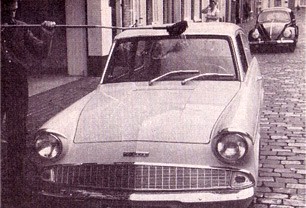 |
Small
Scratches
It is important to check for small scratches or
stone chips that may have damaged the surface of
the paintwork. If the paint has been chipped to
allow the surface metal to appear then it will
need treating immediately to prevent rust forming
on the bodywork.It is suggested that you
allow your Authorised Ford Dealer to treat any
affected areas immediately with the appropriate
materials.
If this is not possible,
approved touch up paints are available through
your Authorised Ford Dealer
Tar
Removal
Tar, or asphalt, used in road making may
sometimes find its way on to the body of the car.
Any spots may be removed with a solution of 2/3
petrol and 1/3 clean engine oil.
Dip a soft cloth into the
mixture and, using one finger, rub the spot
gently until it has been removed. The petrol and
oil should then be removed by washing down with
clean water.
Warning
– This was obviously written when
environmental issues were not so prevalent.
Petrol and Engine Oil must not be poured down a
drain or allowed to enter the watercourse. Petrol
is also highly flammable and should be treated
with caution. The Owner of the site recommends
you buy a proprietary tar removal product from a
Motor Factors, rather than try Ford’s out
dated recommendation.
|
Chrome Plated Parts
Great care should be taken to ensure that the
chrome-plated parts of your car are kept clean
and free from rust. Salt or calcium chloride
(often used in winter time to melt snow or ice)
and seawater can cause damage if allowed to
remain on chromium plated parts.These parts should be
cleaned periodically with a reliable chrome
cleaner, available from your Dealer. Take care
not to use a chrome cleaner which contains
abrasive matter.
|
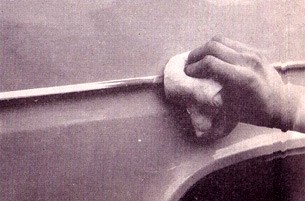 |
Cleaning Upholstery
Leather, leathercloth (PVC), or rayon upholstery
may be cleaned with a damp cloth and a good
quality toilet soap, although an approved
interior cleaner available through your
Authorised Ford Dealer is a suitable alternative.Apply the soap to the damp
cloth and rub the soiled area briskly, then apply
a clean dry cloth, again rubbing the upholstery
surface briskly
Never use polishes, oils,
petroleum or a dry cleaning fluid when cleaning
the upholstery.
|
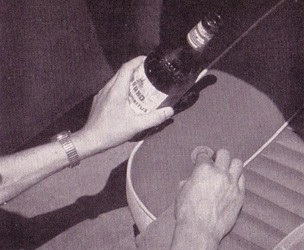 |
Cleaning Carpets
Car carpets are best cleaned with a vacuum
cleaner and an interior car cleaner. Petroleum or
dry cleaning fluids must not be used. |
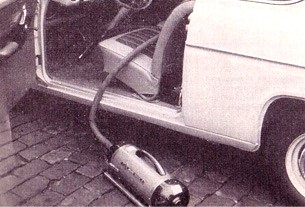 |
Door
Drain Holes
The drain holes at the bottom of each door should
be kept clear by periodically probing with a
piece of wire, being careful not to scratch the
paint.Check the Windscreen is
Clean – (Daily Service)
To ensure you have good visibility whilst
driving, clean your windscreen with a clean dry
cloth and an appropriate vehicle glass cleaner.
Windscreen
Wipers
Occasionally clean the windscreen wiper blades
with windscreen washer fluid, clean water or
soapless detergent.
|
Windscreen Washer (where
fitted)
– (1000 Mile Service)
The fluid in the windscreen washer container
should be maintained at a reasonable level.The windscreen washer
container is located on the left hand side of the
engine compartment on the bulkhead next to the
heater.
The container is
made of an opaque plastic and so you should be
able to see whether the windscreen washer fluid
needs topping up. If the level is low, remove the
cap from the container and fill with a suitable
screen wash solution. Refit the container cap.
|
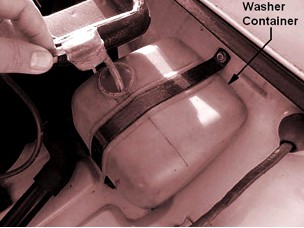 |
| Failure to
operate when the button or plunger is pressed may
be due to a shortage of fluid, blocked spray jets
or a leakage at the connections. To clean the washer jets:
1 - Unscrew the knurled
button one turn; do not remove.
2 – Operate the washer
and allow water to flow freely through the loose
jet to remove any particles of grit.
3 – re-tighten the
knurled button, taking care not to damage or lose
the plastic washer.
4 – Repeat the above
for the other jet. Do not clean both jets at the
same time.
|
nformation taken from Various Ford
Anglia Instruction Books and Handbooks..

Warning -
The Health and Safety bit.
Please note your health may be at
risk if you do not take sensible safety
precautions. Never work under an unsupported
vehicle, do not take shortcuts. If you feel that
the task is beyond your capabilities, then employ
the services of a trained professional. The Owner
of this Website nor the author cannot be held
responsible for any accidents or injury arising
from advice given on this webpage. Safety advice
can be obtained from the RoSPA.
|




|
|

